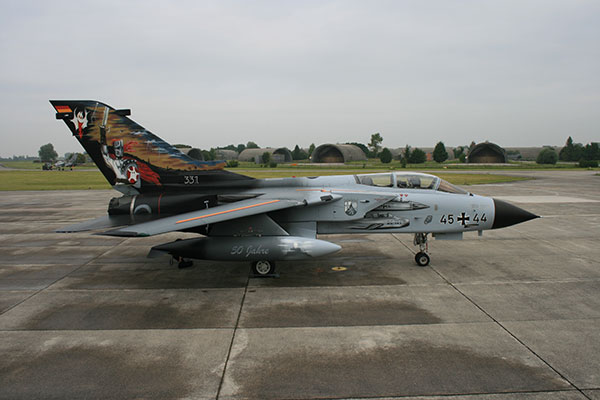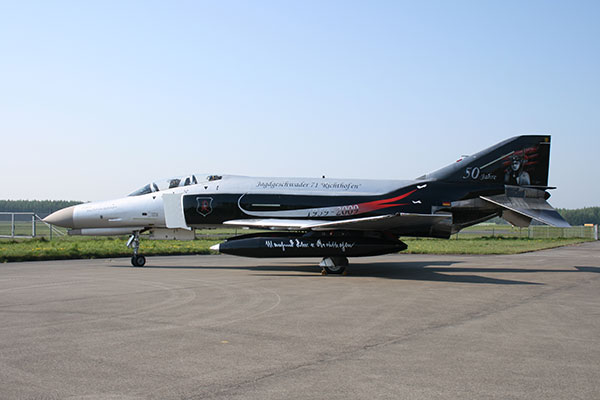Other Design Projects beside full paint jobs
Help with a Tornado at FBW 33 in Büchel
Help with a F4-F Phantom at JG 71 "Richthofen"
Beside my own full projects I also helped with paint jobs in other wings.
In Büchel we airbrushed the anniversary Tornado and in Wittmund we helped with some graphics on their anniversary aircraft.
But on both occasions the Design was not by me and in the case of Wittmund our participitation was only marginal, so I don't want to claim any of those as "my" work.
Aside from doing aircraft designs I 'm working on many projects like creating websites and print work such as brochures, T-shirts, stickers and so on.
But let me enlight you of how a special paint job is done nowadays:
It all starts with an idea. During my active flying time I always came up to my bosses with the idea why don't we do a special paint job for an occasion.
Since 2006 I'm retired from the air force so I cannot do that anymore. But once you have a certain credibility for such a job they ask you because normally there isn't really that much expertise in the wings.
So after 2006 FBW 31 "B" came back to me and asked my whether I want to do that job. And later on headquarters in Berlin became aware of my work so I did a lot of projects after the first Eagle Star 1.0 for them.
If you start a project by your own you are free with the design, if you're doing it for somebody else they give you some benchmarks what they want to have included in the final design.
I then start the projects on my computer. In former times (everything that was airbrushed) the result would only be a kind of impression model, since the projection from a PC to an airbrush is not always 1:1. When airbrushing you are a little bit free with forms although a person like Oswald Boelcke should also look like Oswald Boelcke. After those "airbrush days" the foil wrapping came up and everything you create on the PC looks exactly like that on the aircraft.
This designing was relatively easy early on since they were projects totally unaffected by anyone else. Today there are a lot of intermediate steps before the final design is really final. E.g. all the Eurofighters I did for our Air Force Headquarters in Berlin I did very succesful with our excellent Press and Information Centre over there but the final version was often more or less approved by our Chief of Air Force, GenLt Ingo "Vega" Gerhartz, who is an active Eurofighter pilot by himself and was also Wing commander at Nörvenich when the introduction of the Eurofighter took place (Project "End of an Era").
Other points to consider are to identify a specific aircraft which will get that design. Considerations are e.g. flying time left, planned inspections, availability for the planned amount of time and many more. It wouldn't make sense to choose an aircraft which has very few hours left to the next big inspection. In Tornado times a big inspection would always include a complete stripping of the colour, so why make such a work if an aircraft has such an inspection due in one month.
Another important point which has to be tackled before are the finances. In my active time I was already paid by the air force and the paint wasn't really a factor since it was no difference if the aircraft was painted in camouflage green or more colourful.
But nowadays in the foil era extra material has to be bought and the wrapping itself is normally done by private companies who have a lot more expertise in that. That wrapping has to withstand supersonic speeds and other flying related charges like turbulences. It is not as easy as wrapping your car fender.
So we sometimes hear the argument about these exta costs, but let me assure you, the actual costs are lower than an advertisement in a big newspaper.
And the PR effect is unbelievable bigger than those. E.g. the Air Ambassador was followed all around the Pacific and a lot of dignitaries got their picture in front of it. You cannot have a better visibilty than that.
When everything is fixed a wrapping company has to be found. And since there's still normal procedures in effect different offers have to be obtained. But with more and more projects there is a certain pool of companies to choose from since they also aquired the expertise, since wrapping an aircraft is "slightly" different from wrapping a car. And you don't have a second chance if the first one goes wrong.
If the project is time critical looking for an aircraft and obtaining offers can be done while working on the design since for an offer they only need the amount to be wrapped and not how it should look like.
If the final design is made it has to be approved also by the technical staff in our air force. You wouldn't get an approval if e.g. certain essential markings are not included. Then the real "work" starts. The identified aircraft is cleaned before the wrapping starts because greasy residue and the glue of the wrapping don't work together pretty well.
I provide the design files to the company involved and they start printing the foil. After printing they have to be sealed by another clear foil and everything has to be aired before applying to the aircraft. That process takes about 2-3 days. After that the foil is applied to the aircraft which takes about a week, depending how many people work on that. With more and more projects there's a kind of routine, you know where the setbacks will be and can maybe solve them beforehand. A foil web is about 1,3 meters broad and has a thickness of about 80-110µm.
It's applied with about 5 cm overlapping like a roof covering. All edges have to be sealed later on since you can imagine a slipstream in supersonic regions can quite be destructible. Some element like serials are applied on top of the basic foil since nobody can really pretend where that number would be if it would be included in the basic foil. To give an idea if a foil is warmed it could easily be applied 10 cm to either way on a length of 1 meter. But that fexibility is also needed when working around corners.
If the warapping has been completed a technical officer in the wing checks if everything was applied in the correct way and all essential marking are at the right place and then signs off this aircraft back to airworthy.
When we started with wrapping in the beginning it was a "horror" for me to see the result especially of the colours of the wrapping. I found out that the foil at first looks really matte. That's due to the fact that the clear top coating is not yet attached to the printed basic foil. Nowadays we pull that aircraft out in the sun for some hours and then this matte effect will vanish and the full colours will appear. That was often a problem because of the "spotters" who want to get a picture of such a special paint as the first. So nowadays every wing has their certain spots where they can park the aircraft without anybody seeing it from the base fence. Don't get me wrong, every wing is proud of their new "painted" aircraft, but it's a little bit as seeing the bride before the wedding.
Because this is a private website I don't post any external links, but if you're intersted in my work, a lot of the projects can be bought as model kits from various producers.
back to Home

